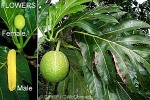Cook Islands Biodiversity Database
Species Page
Artocarpus altilis
KuruBreadfruit
Multimedia & Additional Resources
| Type | Description | Download |
| Flowers, fruit and leaves | 77KB | |
| Leaves, fruit and male flower-catkin | 103KB | |
| Fruit of few-seeded variety | 82KB | |
| Advanced root-shoot | 86KB | |
| Undissected-leaf variety (Tahitian = Rare Autia) | 49KB | |
| Rarotonga varieties 1960 | 167KB |
General Information
Cook Islands Distribution
| Southern Group: Present Makatea: Present | ||||||||
RR |
MG |
AT |
MK |
MT |
AK |
PL |
TK |
MN |
++++ |
++++ |
++++ |
+++ |
P |
++++ |
++? |
+L |
|
| Northern Group: Present | |||||
TN |
MH |
RK |
PK |
NS |
SW |
++++ |
++? |
++? |
+++ |
++? |
P |
Scientific Taxonomy
Artocarpus altilis (S.Parkinson ex Z)
SYNONYMS: Artocarpus communis; Artocarpus incisus; Artocarpus incisa [incl. TC/GW]
TAXONOMY: PLANTAE; ANTHOPHYTA (=Angiospermae); MAGNOLIOPSIDA (=Dicotyledones); HAMAMELIDAE; Urticales; MORACEAE
More Information
SIGNIFICANCE NOTES -
POSITIVE SIGNIFICANCE: Medicine, Food (Fruit 4+), Material (Wood). Comments: A very important food plant. The fruit is cooked in the Umu, baked in (conventional modern) ovens and also boiled. In former times the ripe fruit were preserved by being buried in pits, lined with banana (or plantain) leaves, covered with a further layer of leaves weighted down with stones or earth, and left to ferment. The resulting paste was called Ma‘i and was apparently highly prized (Cheeseman 1903). In addition to the fruit being an important source of carbohydrates and vitamins, the wood, bark, sap, leaves and young stem tips are also utilised: the wood is used to make tables, canoe bailers and boast parts. The bark was formerly used to make a type of tapa called ‘anga. The sap is used as a glue in kite construction; as a weight in the game called pe‘i kaka‘o; as an adhesive/strengthener for supportive dressings on broken limbs; as a waterproofing agent for canoes; and, formerly, as part of a lime to catch birds when mixed with candlenuts. The leaves are used to cover Umu; and the ashes from burnt leaves form part of a concoction (called a‘ei) used to treat shingles. The stem tips (kao) are used as part of a concoction for the treatment of abdominal pains called tupito (Whistler 1990). The timber is soft but lasting, is light and varnishes well.
Sheath of male flower can be dried and burnt to repel mosquitoes (Ma'uke).
IDENTIFICATION: Large tree to 20m. LEAVES alternate, large, to 100x50cm, oval, usually deeply dissected into 3-7 long lobes on each side [a locally rare variety with shieldlike undissected leaves is Rare Autia of Tahiti]; stalk to 5cm. FLOWERS sexes separate on same plant; male yellow, very numerous forming cylindrical spike to 30cm, seeded forms release copious wind-spread pollen, seedless forms release very little pollen; female 1000-2000 fused into a spherical head. FRUIT oval to round, large to 25cmØ, surface of small 5-7-sided disks, ripens yellow-green and leaks a white sap. SEEDS usually absent (one variety has a few seeds, ovoid, 25mm long). Propagated by root-shoots.
GENERAL NOTE: Breadfruit is native in New Guinea and Indonesia. It was first domesticated in New Guinea or Bismarck Archipelago as seeded to seedless cultivars propogated by root-shoots. Seeded to few seeded cultivars are found from New Guinea eastward to Samoa, with the greatest diversity in the Solomons and Vanuatu; and one few-seeded variety to Tahiti (‘Uru Huero). Seedless cultivars were traditionally from Fiji eastward to the Marquesas, and up to Hawaii - and in post-contact times introduced to many tropical countries, including New Guinea.
Gill (1885:175) noted breadfruit and mountain plantains as the staple diet of Rarotonga, such that people spoke of summer and winter as 'breadfruit and winter'. He states that seven varieties were indigenous, and another, formerly deemed sacred, was brought by Tangiia from Tahiti. He mentioned the preparation of poke, breadfruit pudding, mixed in wooden trough, wrapped in banana leaves, and baked; and the preparation of fermented breadfruit paste, known as mai, which remained edible for a year.
Cheeseman (1903) listed the most prized forms as: Kuru-atu, Tatara, Patea, and Kuru Maori. Wilder (1931) listed Kuru atu, Kuru tatara, Kuru patea, Kuru Maori, and Kuru peka as the esteemed varieties. Kuru peka was recorded as having been introduced from the Marquesas and had very small fruit, to 8cmØ.
The variety with the undissected leaves probably originated in either Fiji or Samoa where it is common. It is Uto Lolo in Fiji, Maopo in Samoa and Tonga, Rare Autia in Tahiti, and Mei Aukape in the Marquesas. On Rarotonga it is very rare, with one tree beside Arai-te-Tonga, and it has no known traditional name. The Tahitian variety with a few seeds is Huero with a spiny-skinned fruit. The fruit cooks quickly and it is an esteemed and delicious variety. It is a very prolific producer, and bears most of the year.
Rarotonga is approaching the southern limit of good breadfruit growth. The main fruit season is March to May, with a minor season in November and December. In Samoa the main season is November and December.
Vouchers & References
Vouchers:
Rarotonga: fieldspecimen, 8/2003, Arai-te-Tonga, form with nondissected leaves, only specimen on island, GMcC. Pukapuka: fieldspecimen, 2/2004, widespread in villages, form with deeply dissected leaves, ID GMcC.
References:
p.302 Neal - In Gardens of Hawaii
p.99 Royal Hort. Soc. Index of Garden Plants
p.475 Tropica
p.2/207 A.C.Smith - Flora Vitiensis Nova
p.296 A Cheeseman - Flora of Rarotonga
p.40 Wilder - Flora of Rarotonga
p.373a Whistler - Ethnobotany of the Cook Islands
Data Update History (information):
zTX, zB02, zM02, zD02
Web Resources
Citation Information
McCormack, Gerald (2007) Cook Islands Biodiversity Database, Version 2007.2. Cook Islands Natural Heritage Trust, Rarotonga. Online at http://cookislands.bishopmuseum.org. ![]()
Please refer to our use policy.

